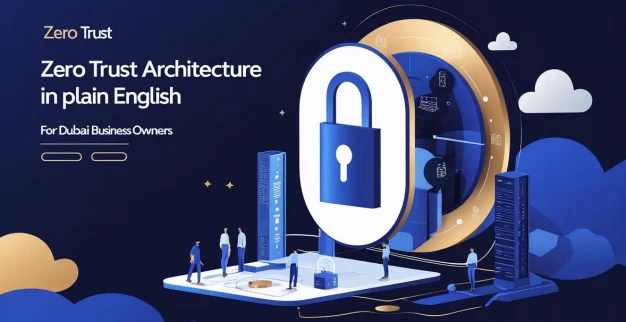Zero Trust Architecture: A Plain-English Guide for Dubai Business Owners
By: Ganesan D
08 July 2025
Category: Network Security
Cybercriminals attack UAE businesses every 44 seconds, making zero trust architecture no longer optional for Dubai companies of all sizes. Gone are the days when firewalls and VPNs could adequately protect your business data. Today's distributed workforce, cloud applications, and sophisticated cyber threats demand a fundamentally different approach to security.
Zero Trust Security Dubai has evolved from a theoretical concept to a business necessity, specifically for small and medium enterprises facing the same threats as larger corporations but with fewer resources. However, many business owners mistakenly believe implementing robust cybersecurity frameworks is too complex or expensive for their operations. In fact, the cost of a data breach far exceeds the investment in preventative measures, with UAE organizations losing an average of $5.34 million per breach.
What is Zero Trust Architecture?
Zero trust architecture fundamentally reimagines cybersecurity by eliminating the concept of implicit trust. At its core, this security framework operates on a deceptively simple yet powerful premise: nothing inside or outside your network should be trusted by default.
The 'never trust, always verify' principle
The cornerstone of zero trust architecture is the "never trust, always verify" principle—a philosophy that requires continuous validation of every user, device, and connection attempting to access resources. First introduced by John Kindervag at Forrester Research in 2010, this approach challenges the traditional assumption that anything inside a corporate network perimeter is inherently safe.
Zero trust flips the conventional security mindset on its head. Instead of assuming security within your network boundaries, it operates under the assumption that your network is already compromised. This paradigm shift means every access request—regardless of source—is treated as potentially malicious until proven otherwise.
Why it matters in 2025
By 2025, zero trust architecture has become essential for several compelling reasons. According to Gartner, 63% of organizations will adopt zero trust as their foundational security model. This widespread adoption stems from significant shifts in how businesses operate.
First, the expansion of remote and hybrid work has fundamentally blurred traditional network boundaries. Employees now routinely access systems from personal devices, unmanaged networks, and multiple cloud platforms. Traditional VPNs that grant complete network access once authenticated create dangerous security gaps.
Core Principles of Zero Trust
1. Continuous verification
Zero trust architecture rejects the notion of persistent trust. Even after initial authentication, the system continuously evalus your right to access resources. This principle demands that every user, device, and network flow must be authenticated and authorized on an ongoing basis.
For Dubai SMBs, this means your security systems are constantly asking "Is this really still you?" throughout a session, not just at login. The system examines multiple credentials and behaviors to gain deeper understanding of users and how they interact with your network [9].
2. Least privilege access
This principle asserts that users and applications should be granted access only to the data and operations they absolutely require to perform their jobs.
Least privilege access helps:
- Reduce horizontal privilege escalation risks by removing unused permissions [10]
- Minimize vertical privilege escalation threats by replacing overly permissive access with more restrictive alternatives [10]
- Limit the blast radius of any potential security incident [11]
For Network Security Dubai implementations, this principle means carefully evaluating which employees need access to which resources and ensuring they have "just-enough" and "just-in-time" access to perform their roles [12].
3. Micro-segmentation
Micro-segmentation divides your network into isolated, secure zones to contain threats and prevent lateral movement. Unlike traditional perimeter security, this approach creates internal boundaries throughout your network.
Through micro-segmentation, Dubai businesses can:
- Isolate workloads to limit the effect of malicious lateral movement.
- Apply security controls based on each segment's specific requirements
- Strengthen regulatory compliance by restricting access to sensitive data
This approach is especially valuable in multi-cloud environments where traditional network boundaries have dissolved. Modern micro-segmentation solutions provide visibility, granular security, and dynamic adaptation to changing business needs.
4. Assume breach
Perhaps the most transformative principle of zero trust is the assume breach mindset. This approach acknowledges that perfect prevention is impossible and operates as though attackers are already inside your network.
For Cybersecurity for Small Businesses Dubai, this principle represents a philosophical shift from optimistic security ("we're probably safe") to realistic security ("we must verify everything"). By assuming compromise, your security becomes proactive rather than merely reactive.
5. Device and user authentication
Identity verification forms the cornerstone of trust establishment in zero trust architecture. Dubai businesses must confirm both who a user is and whether their device is secure before granting access to corporate resources.
Effective device and user authentication means:
- Verifying the user's identity through multiple factors beyond passwords
- Confirming the device's security posture before allowing connection
- Pinning users to specific devices through policy
This two-pronged approach helps Dubai SMBs block account takeovers and minimize authentication friction for legitimate users.
6. Real-time monitoring
The final principle ties everything together through continuous observation and analysis. Real-time monitoring collects and analyzes data across your entire IT environment to detect anomalies and respond to potential threats.
This principle enables Dubai businesses to establish baseline user behaviors, with deviations triggering alerts to security teams. Comprehensive monitoring should focus on users, devices, and services to establish their cyber health.
Through micro-segmentation, Dubai businesses can:
- Isolate workloads to limit the effect of malicious lateral movement
- Apply security controls based on each segment's specific requirements
- Strengthen regulatory compliance by restricting access to sensitive data
This approach is especially valuable in multi-cloud environments where traditional network boundaries have dissolved. Modern micro-segmentation solutions provide visibility, granular security, and dynamic adaptation to changing business needs.
Why Dubai Businesses Need Zero Trust Now
The financial impact of data breaches in the UAE has reached unprecedented levels, with the average cost jumping to AED 32.13 million in 2024. This alarming figure underscores why Dubai businesses must transition to zero trust architecture immediately.
Rising cyber threats in the UAE
Cyber attacks against UAE organizations have intensified significantly. Ransomware incidents increased by 32% in 2024 compared to the previous year. The financial sector remains particularly vulnerable, now facing an average breach cost of AED 22.14 million, up from AED 21.66 million in 2023.
Remote work and cloud adoption
The shift to hybrid and remote work has fundamentally altered the security landscape for Dubai businesses. As employees access sensitive data from home networks using various devices, the traditional network perimeter has essentially dissolved. Consequently, organizations face a substantially larger attack surface, with personal devices often lacking essential security controls.
At the same time, Dubai companies are rapidly migrating to cloud platforms, creating security gaps through misconfigurations and unpatched systems. Zero Trust Security Dubai solutions address these challenges by continuously verifying every access request regardless of origin.
How Zero Trust Works in Practice
Identity and access management (IAM)
IAM serves as the cornerstone of zero trust implementation, functioning as the policy decision point for enforcing access controls. In practice, IAM systems verify user identities through multiple authentication factors beyond passwords. This continuous verification process evaluates signals such as user behavior, device health, and location to dynamically adjust access permissions.
For Dubai SMBs, implementing IAM effectively means:
- Centralizing authentication through single sign-on (SSO) to ensure consistent policy enforcement
- Enabling multi-factor authentication to reduce user session risk
- Applying conditional access policies that automatically analyze signals to enforce organizational access rules
IAM solutions enforce least privilege principles by meticulously defining access policies tailored to specific user roles, thereby minimizing the network's attack surface.
Endpoint and device security
Zero trust requires treating all endpoints—including corporate and personal devices—with the same level of scrutiny. This approach applies identical security policies regardless of device ownership or location.
Endpoint security in zero trust architecture involves:
- First, establishing device compliance policies that verify security requirements before granting access
- Subsequently, implementing application protection policies that control what users can do with data after access is granted, such as restricting file saving to untrusted locations
Network segmentation and control
Within zero trust frameworks, networks are divided into smaller, isolated segments where specific workloads are contained. Unlike traditional models, each segment maintains its own access controls to prevent lateral movement if one area is compromised.
This microsegmentation creates secure zones with strict ingress and egress controls that minimize the potential impact of unauthorized access. Primarily, it helps Dubai businesses isolate critical assets behind microperimeters that limit access solely to authorized users and purposes.
Common Challenges and How to Overcome Them
Lack of internal expertise
Zero trust implementation requires specialized skills that existing IT teams may not possess. Indeed, approximately 80% of organizations struggle with implementation when legacy infrastructure is involved. This expertise gap creates risk during transition periods when both old and new security models operate simultaneously.
To address this challenge, Dubai businesses should focus on comprehensive training programs and consider partnering with experienced security consultants during implementation phases. Alternatively, phasing in zero trust principles allows teams to develop expertise incrementally while maintaining operational continuity.
Choosing the right vendor or partner
Selecting appropriate vendors presents another major hurdle, primarily because many technology providers label their products as "zero trust" without meeting core requirements. Amid industry hype, businesses must approach vendor claims with healthy skepticism.
When evaluating potential partners, Dubai businesses should ask:
- Does the solution extend beyond basic network access controls?
- Can it integrate with existing infrastructure investments?
- Does it support legacy systems that cannot accommodate modern authentication methods?
Remember that zero trust isn't a single product but rather a comprehensive framework requiring multiple integrated components. The ideal partner will help build a holistic security model rather than selling a single-point solution.
Conclusion
Zero trust architecture represents a fundamental shift in cybersecurity thinking for Dubai businesses facing increasingly sophisticated threats. Traditional security models simply cannot protect organizations when network boundaries have dissolved due to remote work and cloud adoption.
Zero trust architecture ultimately delivers what Dubai businesses need most: protection for sensitive data, compliance with regulations, and preservation of customer trust. The question no longer centers on whether companies should adopt zero trust, but rather how quickly they can implement this essential security framework to safeguard their digital assets against evolving threats.



